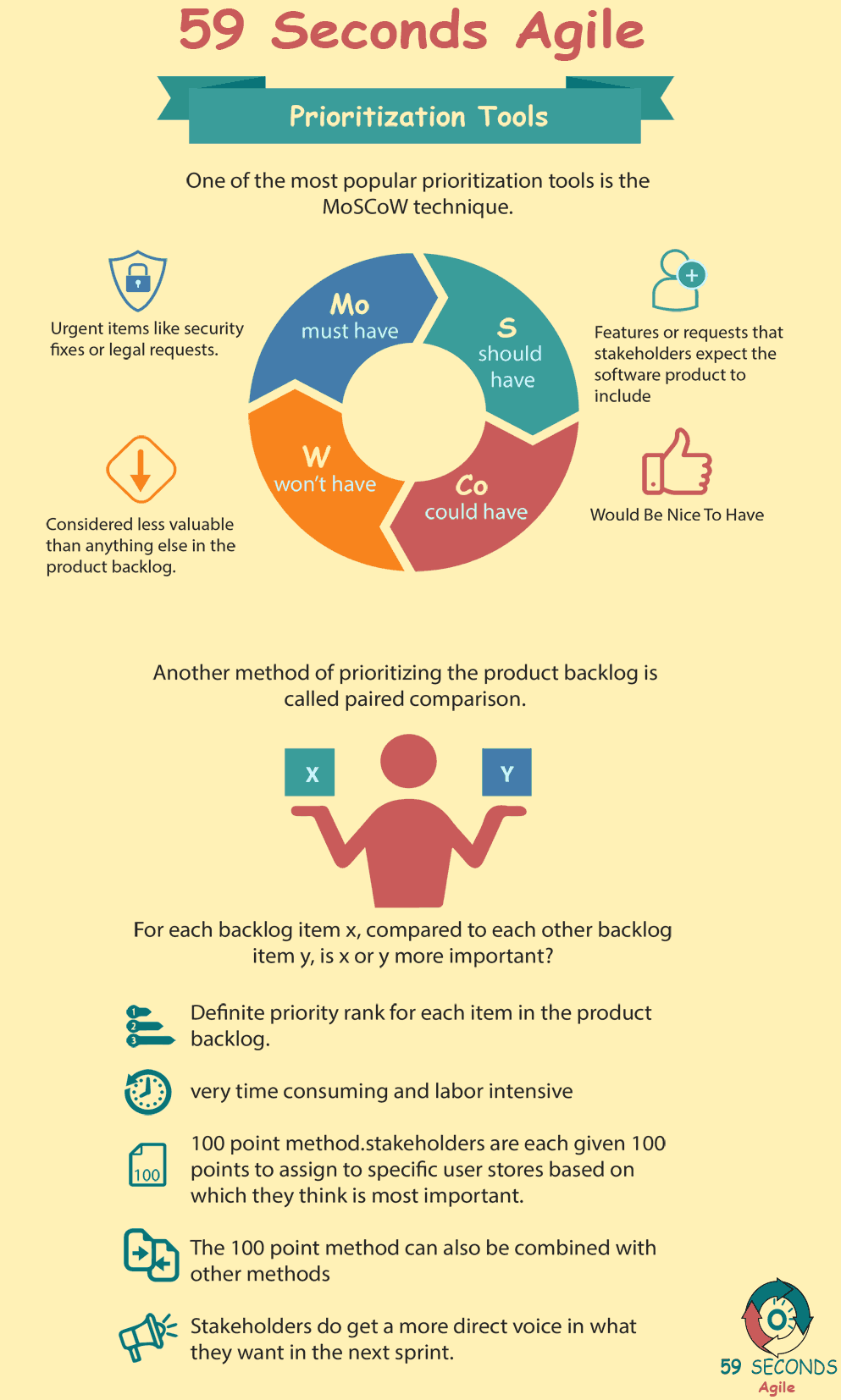What is Scrum Product Backlog Prioritisation and what role do the Scrum Team play within the process? Scrum Product Backlog Prioritisation consists of several elements, each element has the participation of the members of the scrum team.
Scrum Product Backlog Prioritisation
A 59 Seconds Agile Video Animation
Scrum Product Backlog Prioritisation for Developers
A 59 Seconds Agile Article
In the Scrum framework, the scrum product backlog is an ordered list of all the work needed for development of the product. It comprises of user stories, bugs, technical work and knowledge acquisition. The items in the product backlog are driven from the product roadmap, where the Product roadmap is a strategic plan that shows the evolution of the product on different release phases. The product roadmap is written by the product owner with the collaboration of the stakeholders. The items in the roadmap show the long-term vision for the product. The items in the product backlog are workable features and are detailed in comparison to the abstract goals defined in the product roadmap.
Scrum Product Backlog Prioritisation: Estimates
Both the product owner and the development team work on the definition of the items and their details in the product backlog. The Development team estimates how much work is needed for each item in the product backlog and the prioritized items in the backlog are scheduled to be worked on iteratively within each sprint.
Based on their capacity, the development team decides when and how each item is delivered. But the Organization and prioritization of the backlog items are done by the product owner. For this purpose, the product owner receives feedback from development team and customers on each backlog item. The product owner can change the priorities at any point of the project and is responsible for the backlog. The feedback received from the stakeholders are reflected in the reprioritized backlog before each sprint planning session. During the planning session, the items of the product backlog are revisited and refined both by the development team and the product owner.
Scrum Product Backlog Prioritisation: Project planning
In project planning, the product owner is required to prioritize the backlog items to fulfill the requirements of the stakeholders and deliver value to the customers. Without prioritization, the development team may work on items that deliver limited or no value to the product. The scrum master coaches the team on the importance of prioritization and the application of different prioritization metrics.
Scrum Product Backlog Prioritisation: Criteria
There are different criteria for ordering and prioritizing the backlog items such as value, risk, uncertainty, and dependency. Value or business value reflects the importance of the features required by the customer. The more valuable items are prioritized first in the backlog. The items that do not bring any business value to the product, are either removed from the product backlog or deferred to later stages. Another important metric for prioritization is risk. A risk is correlated with uncertainty. The more uncertainty, the riskier the project or task is. By implementing the riskier items first in the product backlog, the developers reduce the uncertainty and ambiguity from the product. This leads to a higher quality product.
Prioritisation
Releasability is another criterion for product backlog prioritization. Releasability means being able to release product increments early and frequently. Each release should include a functionality desired by the customer. Releasing the product increment early will help the development team to get feedback from the customers and understand how to continue implementation in future while allowing the stakeholders to benefit from the added value of the product earlier. Another prioritization criterion is the dependency. Dependencies can be between requirements or between several teams working on the same product. The dependencies should be resolved by the scrum team. If it is not the case, they affect the product backlog prioritization. The items which other items depend on should be implemented first.
There are different prioritization approaches for ordering backlog items such as MoSCoW, paired-comparison and the 100-point method.
Prev <— Continue Reading —> Next
Learn More: Product Backlog Prioritization
User Stories Applied
A 59 Seconds Agile Book Review
User Stories Applied by Mike Cohn is one of our favourite books on Agile User Stories. The book starts with an overview into user stories, and details what a user story is and the different aspects of them. He then discusses how to go about writing a user story, and provides details of the INVEST criteria that can be used to determine if the story is meeting all of its objectives. Next Mike gives an in depth discussion of who user stories are written for and where to begin when gathering the details for them. The book then discusses acceptance testing user stories, including how to go about specifying these criteria and the responsibilities of the development team and customers during this process.
Prev <— Continue Reading —> Next
Learn More: Product Backlog Prioritization
Scrum Product Backlog Prioritisation
A 59 Seconds Agile Infographic

Prev <— Continue Reading —> Next
Learn More: Product Backlog Prioritization
Prev <— Continue Reading —> Next
Learn More: Product Backlog Prioritization
Our Favourite Agile Books
We found these books great for finding out more information on Agile Scrum:

